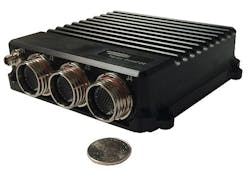Small-form-factor embedded computing offers new SWaP-based distributed design paradigm
It's true that SWaP-constrained electronics technologies like small-form-factor (SFF) embedded computing does enable big power in small spaces, but the ever-shrinking size of today's electronics is helping systems designers think of space in a whole new way.
Small-form-factor embedded computing, like COM Express, PCI/104 Express, the Smart Mobility ARChitecture (SMARC), and Mini Embedded Technology eXtended (Mini-ETX) are shaking up the embedded computing design paradigm and are helping designers come up with distributed embedded computing architectures, rather than rely solely board-and-backplane designs.
On its face this may not sound like such a big deal, but it can help systems designers think about placing computer components where they make sense, rather than consolidating computing in board-and-backplane boxes.
When it comes to digital signal processing (DSP), designers often talk about placing computing components as closely to antennas and sensors as possible. Small-form-factor embedded computing may offer just the ticket.
Using a distributed architecture based on small-form-factor embedded computing, for example, designers could place analog-to-digital (A/D) and digital-to-analog (D/A) converters with some field-programmable gate array (FPGA) pre-processing in a small package next to sensors, and then route this data over high-speed optical fiber interconnects to more powerful processors conveniently placed elsewhere in the system.
Moreover, small-form-factor embedded computing can help designers place components where they fit best, rather than worry about finding a space big enough to accommodate a traditional computer box.
Potential benefits of distributed embedded computing architectures don't end there. The whole idea of dividing computers into separate parts may offer advantages in thermal management, controlling electronic emissions, and graceful degradation when things go wrong.
A distributed computing system might be able to tolerate overheating, power surges, or battle damage better than a centralized board-and-backplane computer box. Bring down an entire box, and the military mission might be over, but bring down a preprocessor memory package, and the mission might be able to continue with degraded performance.
Distributed architectures enable designers to think not only about spreading out relatively small components over a larger system, but also about spreading out waste heat over a larger area. Hot processors, for example, could be located near potential cooling sources like flowing air or fuel. Components susceptible to electromagnetic interference (EMI) could be physically separated from EMI sources, and relatively cool-operating components like memory and controllers could go near the center of the system where heat is not a big challenge.
Serial networking becomes a central concern for distributed architectures, and confronts designers with crucial decisions on whether to use optical fiber, copper wire, or even wireless networking. Fast Ethernet and other advanced network architectures, however, are making these decisions easier than they used to be.
Now what about the potential of wireless networking for distributed computing architectures? This approach might offer advantages like ease of maintenance and future technology insertion and upgrades, adding computer capability to legacy systems, and bringing handheld devices with compatible wireless interconnects into the system when necessary.
Granted, there are tradeoffs that designers must consider for wirelessly distributed systems. Cyber security, outside electronic interference, limited data throughput, and a lack of the most powerful processors available today come to mind.
Still, small-form-factor embedded computing is on the verge of introducing a deep new design paradigm for aerospace and defense applications. Possibilities are limited only by the imagination.
Learn more: search the Aerospace & Defense Buyer's Guide for companies, new products, press releases, and videos

